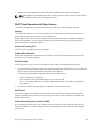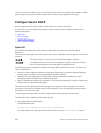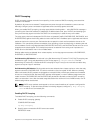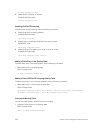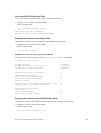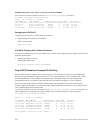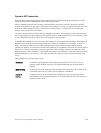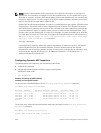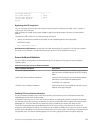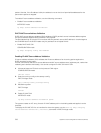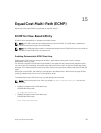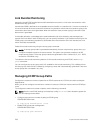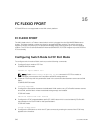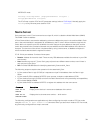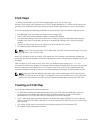
---------------------------------------
Valid ARP Requests : 0
Valid ARP Replies : 1000
Invalid ARP Requests : 1000
Invalid ARP Replies : 0
Dell#
Bypassing the ARP Inspection
You can configure a port to skip ARP inspection by defining the interface as trusted, which is useful in
multi-switch environments.
ARPs received on trusted ports bypass validation against the binding table. All ports are untrusted by
default.
To bypass the ARP inspection, use the following command.
• Specify an interface as trusted so that ARPs are not validated against the binding table.
INTERFACE mode
arp inspection-trust
Dell Networking OS Behavior: Introduced in the Dell Networking OS version 8.2.1.0, DAI was available
for Layer 3 only. However, the Dell Networking OS version 8.2.1.1 extends DAI to Layer 2.
Source Address Validation
Using the DHCP binding table, the Dell Networking OS can perform three types of source address
validation (SAV).
Table 16. Three Types of Source Address Validation
Source Address Validation Description
IP Source Address Validation Prevents IP spoofing by forwarding only IP packets
that have been validated against the DHCP binding
table.
DHCP MAC Source Address Validation Verifies a DHCP packet’s source hardware address
matches the client hardware address field
(CHADDR) in the payload.
IP+MAC Source Address Validation Verifies that the IP source address and MAC source
address are a legitimate pair.
Enabling IP Source Address Validation
IP source address validation (SAV) prevents IP spoofing by forwarding only IP packets that have been
validated against the DHCP binding table.
A spoofed IP packet is one in which the IP source address is strategically chosen to disguise the attacker.
For example, using ARP spoofing, an attacker can assume a legitimate client’s identity and receive traffic
addressed to it. Then the attacker can spoof the client’s IP address to interact with other clients.
The DHCP binding table associates addresses the DHCP servers assign, with the port on which the
requesting client is attached. When you enable IP source address validation on a port, the system verifies
that the source IP address is one that is associated with the incoming port. If an attacker is impostering as
a legitimate client, the source address appears on the wrong ingress port and the system drops the
Dynamic Host Configuration Protocol (DHCP)
335



